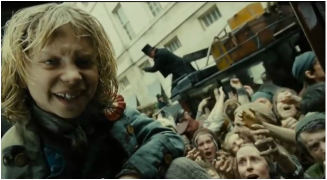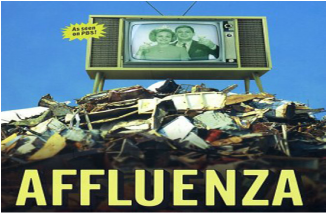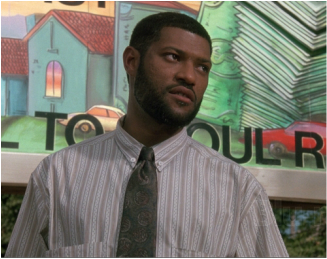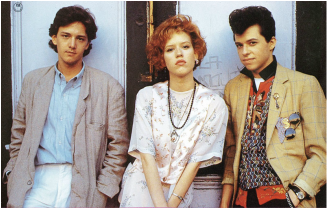 Bunny Colvin asks, "what makes a good corner boy?" Bunny Colvin asks, "what makes a good corner boy?"
Tags: class, children/youth, culture, inequality, theory, bourdieu, cultural capital, institutions, the wire, 00 to 05 mins
Year: 2006 Length: 2:57 Access: YouTube Summary: In this clip from season 4 of The Wire, the troubled youth discuss what makes a good "corner boy" and illustrates how cultural capital works. As demonstrated in the clip (and throughout season 4), they lack the cultural capital of professional settings. For example, they speak out of turn, disrespect authority, and speak inappropriately for the context. But when Bunny Colvin asks the students what makes a good "corner boy," the students come alive and quickly describe the necessary traits: "keep the count straight," "don't trust nobody"; and "keep your eyes open." Their knowledge about, and interest in, working the corner illustrates the cultural capital that the teenagers possess. It is useful in navigating the streets and being a successful member of the drug-dealing gang hierarchy. The issue is that broader society does not value this form of cultural capital, which is possessed more by poor, inner-city children. Instead, society values the kinds of cultural capital that are more common middle-class suburban schools and families. In other words, the problem is not that the boys do not have any skills, but they do not have a certain type of skills. For a complementary example from The Wire, watch the restaurant scene, in which these same children lack the cultural capital necessary for eating at a fancy restaurant. The kind of knowledge and skills necessary for that setting (e.g. knowing appropriate behavioral norms, understanding menu items, being comfortable in that setting) could be helpful in a professional job interview or networking. The different values placed on cultural capital more common among middle-class families illustrate how they are more likely to reproduce their class position, thus reinforcing the class structure across generations. Like the unequal distribution of wealth, or high-quality schools, inequalities in cultural capital help to shape different economic opportunities and mobility. Submitted By: Paul Dean
3 Comments
 A boy sings to the rich about the plight of the poor. A boy sings to the rich about the plight of the poor.
Tags: capitalism, class, economic sociology, inequality, marx/marxism, political economy, theory, class consciousness, class conflict, 00 to 05 mins
Year: 2012 Length: 2:48 Access: YouTube Summary: This clip from the 2012 film of the musical Les Misérables begins by showing beggars and urchins pressing against the carriages of the rich, begging for food or money. Gavroche, the lead urchin, explains to the audience the political situation in France (in 1832) and then joins a crowd of people expressing their anger at the situation so many of them are in. For the most part, the classes are polarized binto the rich and the poor (lower and upper classes). Particularly in the case of the working class, there seems to be minimal gap between their actual needs and experiences and their attitudes toward their situation. The scene and its accompanying song reflect key concepts in much of Marx and Engels' Manifesto of the Communist Party. For example, it illustrates the lower class's class consciousness, as both their objective class position and subjective consciousnesses are aligned; they realize their own position in the class system and how it affects them. As noted by Marx and Engels, the poor can “live only so long as they find work, and who [can] find work only so long as their labour increases capital” and are therefore wholly dependent on the upper class for their livelihood. However, the upper class is not acting in the interests of these poor, and the leaders that could make decisions to the benefit of the poor are absent and unhelpful. Therefore, the only people that can act in the interests of the lower class are the poor themselves. In order to live the life they want to live, the poor need to rise up collectively and make the necessary changes in the system. As this collective action is “continually being upset again by…the workers themselves” (Marx), the young men function to facilitate the inevitable conflict with the upper class. When Gavroche explains the continuous political loop the people have been in, finding themselves struggling again after seeming to have fixed the problem, he demonstrates the idea that class struggle is continuous and, according to Marx, present in “the history of all hitherto existing society.” With this understanding of the sociological factors in play in this clip, the viewers can make connections between the clip, albeit fictional, and other instances of class conflict throughout history. It is a strong representation of the differences between different classes and the consciousness that leads to conflict and change. Submitted By: Kiersten Payne  Sandra Bullock stereotypes a working-class Hispanic man who changes the locks on her house. Sandra Bullock stereotypes a working-class Hispanic man who changes the locks on her house.
Tags: class, intersectionality, race/ethnicity, boundary work, stereotypes, 00 to 05 mins
Year: 2004 Length: 2:12 Access: YouTube Summary: This clip from Crash begins after a woman (played by Sandra Bullock) was robbed and is now getting the locks on her house changed. Sandra Bullocks' character (an upper-middle class white woman) pulls her husband aside and demands to change the locks in their house a second time because she believes the man is going to sell their key to a “gang banger friend.” The man changing the locks is Hispanic, and Bullock describes him as "a gang member ... with a shaved head, pants around his ass, and a prison tattoo." When her husband dismisses her assumptions about the man, she says that they should follow her instincts about this because when the two were previously attacked, she said she knew it was going to happen based off of the way the two black men (who robbed her) looked. The wealthy white woman expressed both racial and class stereotypes based on the man's clothes, tattoos, hair style, and race. A stereotype is a an exaggerated or distorted generalization about an entire category of people that does not acknowledge individual variation, and often forms the basis for prejudice and discrimination. Bullock stereotypes him and assumes he would sell the key to her house, which is illegal and immoral, just to get more money. As she continues her loud rant in the presence of the Hispanic working-class man and African-American police agents, she exhibits her class and white privilege in which she can be so disrespectful without any real consequences. She clearly places him in a different category than her and as someone who is beneath her. This also illustrates Lamont's concept of boundary work, in which people draw boundaries between people like themselves and perceived others. At the end of the video when the Latino man and her make eye contact, it is very telling that he did not say anything, but he simply puts down both of the keys and leaves. This action suggests his awareness of his lack of power in the situation, and his discomfort in challenging the woman on her racist and classist beliefs. Viewers are encouraged to consider how people develop, draw upon, and challenge such stereotypes. Submitted By: Bella Moore  Stephen Colbert discusses the politics of class warfare. Stephen Colbert discusses the politics of class warfare.
Tags: class, inequality, marx/marxism, theory, american dream, class conflict, ideology, 00 to 05 mins
Year: 2006 Length: 3:50 Access: The Colbert Report Summary: This segment of "The Word" from the Colbert Report focuses on class warfare. It examines John Edwards' 2006 presidential run in which he wanted to wage a war on poverty in order to restore the “dream that is America.” His platform proposed to reduce poverty by 30% in ten years and totally in thirty. Colbert makes a bold claim that the Bush administration worked too hard to “create” poor people. He cites that “the amount of people living under the poverty line had increased by 4.1 million,” while Congress has voted against raising the minimum wage 9 years running and given themselves a raise in recent months. He argues that we need the poor because they provide inspiration for the rest of us to work hard in order to succeed, just like the American Dream created hundreds of years ago. This illustrates the ideological functions of the American dream. Specifically, it suggests that there are ample opportunities to get ahead in life, so if someone is struggling economically, then they are at fault. This way of understanding American society ignores the dramatic structural inequalities, and helps to keep the working class from resisting the class system and keeps the wealthy in control. The clip also illustrates Marx's concept of class struggle, in which the class interests of the capitalist class and working class are inherently opposed, thereby making class conflict inevitable. The class interests of business owners who oppose raising the minimum wage, or the wealthy members of Congress who voted to give themselves a raise, are diametrically opposed to the interests of the working class, who would clearly benefit from an increase in the minimum wage and other economic opportunities. Furthermore, it is the capitalist class which controls the means of production (and government), and therefore are in a better position to benefit themselves. Instead of raising wages or implementing better conditions, they work to maximize their own profits and salaries, thereby hurting everyone else. Submitted By: Dan Weintraub  This ad celebrates materialism and the American Dream. This ad celebrates materialism and the American Dream.
Tags: class, consumption/consumerism, culture, marketing/brands, marx/marxism, nationalism, theory, american dream, commercial, ideology, 00 to 05 mins
Year: 2014 Length: 1:02 Access: YouTube Summary: This Cadillac commercial starts with actor Neal McDoungh looking over his private, in-ground pool as he poses the question “Why do we work so hard? For this? For stuff?” He talks about why Americans don’t slack off like other countries, which take a whole month of vacation. He spouts a list of famous innovators, and asks if we think they took an entire month off? Nope, because they were busy being innovators, and living the American dream. The ad is exemplary of the hegemonic ideology of the American Dream. Ideology is a collection of shared beliefs and ideas for understanding the social world that explain and justify power or challenge social relations. In this commercial we see that the actor has achieved economic success. As he walks around his expensive house and material possessions, he discusses why it’s great to be a hard working, no vacation-taking American. McDoungh directly calls out our desire for all the “stuff” which aligns with the value our culture places on material things as a value of success. Then at the end of the commercial he directly ties together the concept that taking only two weeks off means we can have more stuff, enforcing the ideology that hard work will get you the things you want: “It’s pretty simple, you work hard, you create your own luck, and you gotta believe anything is possible.” Similar to a second Cadillac ad, the emphasis on "American" suggests that this idea is a uniquely American characteristic, even though upward mobility is more common in other developed countries. It is like other dominant ideologies that are reproduced throughout institutions (i.e. the media), and this particular ideology is hegemonic because for many Americans, this way of understanding our culture is taken-for-granted. It reproduces existing class relations because it suggests that material success is based upon our degree of effort, passion, and hard work (rather than our class background or other environmental factors), and that if we are not successful, then we accept that we only have ourselves to blame. After watching this ad, it is interesting to see this Ford commercial. It emphasizes local efforts, and parallels the format and style of the Cadillac ad (it really makes fun of the smugness of their competitor, Cadillac). Submitted By: Alexis Blaylock  Affluenza is a combination of "affluence" and "influenza" to critique the disease of consumerism. Affluenza is a combination of "affluence" and "influenza" to critique the disease of consumerism. Tags: capitalism, class, consumption/consumerism, culture, economic sociology, health/medicine, inequality, marketing/brands, affluenza, american dream, keeping up with the joneses, status treadmill, 06 to 10 mins, 21 to 60 mins Year: 1997 Length: 10:13 (entire documentary is 56:00) Access: YouTube Summary: This clip (start 2:12; end 12:35) from the documentary Affluenza (based on the book), defines the concept and consequences of affluenza. Using the metaphor of disease, affluenza can be defined as a bloated, sluggish and unfulfilled feeling that results from efforts to keep up with the Joneses; an epidemic of stress, overwork, waste and indebtedness caused by dogged pursuit of the American Dream; and an unsustainable addiction to economic growth. This clip notes that "never before has so much meant so little to so many." It can cause headaches and depression amongst other symptoms, and the narrator notes that if it goes untreated, the disease can cause "permanent discontent." In addition to discussions of consumer culture, the clip works particularly well with the book, The Spirit Level. Using a variety of quantitative data, authors Wilkinson and Pickett argue that more unequal societies suffer a variety of social problems. The reason, they propose, is that more unequal societies place more emphasis on material success to prove one's worth in society. This constant drive to display one's material success can never be satisfied and leaves individuals throughout the social hierarchy being unfulfilled. In other words, unequal societies are more likely to suffer from affluenza, and the negative social and health outcomes (e.g. lower life expectancy, higher infant mortality, higher mental illness, higher drug use, etc). The narrators in the video clip further note that while the disease is very contagious (due to extensive marketing and the rise of consumer culture), it is treatable. Viewers might peruse the videos in our social movements category and other web resources for ideas of how to cure affluenza. The documentary website from PBS also offers a teaching guide. Submitted By: Paul Dean  A vintage video game is used to discuss Marxism. A vintage video game is used to discuss Marxism. Tags: capitalism, class, economic sociology, marx/marxism, political economy, theory, alienation, dialectical materialism, philosophy, subtitles/CC, 00 to 05 mins Year: 2014 Length: 3:51 Access: YouTube Summary: This video is part of a series of 8-bit Philosophy, which seeks to “communicate even the most complex of philosophical concepts in a fun, easy-to-understand way.” It uses vintage video games (from the original Nintendo) to explain complex philosophical ideas. Using quotes from The German Ideology and other works, with altered scenes from Super Mario Brothers, the narrator explains several concepts within Marxist theory. For example, the narrator explains that Marx argued it was not ideas that drive historical change, but "it is our conflict arising out of our relation to material goods" that shapes history. This process of historical materialism is explained in terms of the economic systems and social relations of a society; it is simultaneously illustrated using a character from the video game (Toad) and its weapons (a turnip) that reflect commodities that the character produces. Other concepts include exploitation, the four forms of alienation, and communism—all placed in the context of familiar Super Mario Bros references, such as Bowser, collecting coins, and the classic background music. Submitted By: Paul Dean  Who is to blame for students failing in school? Who is to blame for students failing in school? Tags: children/youth, class, education, inequality, ideology, individualism, meritocracy, sociological imagination, 00 to 05 mins, 61+ mins Year: 2010 Length: 1:37 (full film is 81:00) Access: YouTube Summary: This extra is from The Lottery, a documentary that examines the controversy around public schools, charters schools, and the educational reform movement. It follows the lives of four families in New York City who applied to the lottery to enter one of the best charter schools in the city. This short clip features person-on-the-street style interviews, where everyday people describe their views on why students don't succeed in schools (or watch the full film). Some of the responses include: "the only thing from stopping you from making it is your own self ... you can't blame the system. You blame yourself"; "the problems with our educational system are cultural"; "in one city you can have garbage schools up in our neighborhood, and then down there, amazing schools. and you can't tell me that's not race-based"; "if my school had been better, then I believe I wouldn't be on the streets." Viewers can be encouraged to consider which of the response reflect the sociological imagination, as compared with purely individualistic explanations. The clip could also be used to examine the role of ideology in American society. Individualistic explanations of schooling failures reflect the ideology of the American Dream, in which anyone can succeed if they work hard enough (and that the US functions as a meritocracy). This strong form of individualism serves to reinforce schooling inequalities by shifting the blame from structural forces (e.g. the distribution of school funding, class inequality) to individuals (children or their parents). This ideology obscures the reality, as shown in this Oprah clip and this mini-documentary, that dramatic inequalities in our public school system lead to different outcomes for students based on class, and often race. As the full film shows, thousands of students try to opt out of the failing public school system by entering the lottery, but only a small number will win the arbitrary process. On the other hand, wealthier families can purchase homes in better school districts or send their children to private schools; while winning the lottery is entirely by luck, the class system and educational funding are not. Submitted By: Paul Dean  Laurence Fishburne explains gentrification in Boyz N the Hood. Laurence Fishburne explains gentrification in Boyz N the Hood. Tags: capitalism, class, community, inequality, race/ethnicity, rural/urban, gentrification, housing, neighborhood succession, racism, 00 to 05 mins Year: 1991 Length: 4:18 Access: YouTube Summary: Gentrification radically transformed my neighborhood. Growing up in and around east Austin, I have experienced first-hand the changes that can occur within an area over a mere decade. As a child, I visited family members throughout east Austin. All of us are Latino, and everybody not only knew everyone else, but also where they lived. Now as the city rapidly grows, many in my family are being forced by rising property taxes to sell their homes. These homes are primarily being bought up by young, affluent, white real-estate developers, who are scrapping such dwellings and doing complete renovations in order to attract young, affluent, white occupants. This scene from the film Boyz N the Hood (1991) can be used to teach students about gentrification: "the process of renewal and rebuilding accompanying the influx of middle-class or affluent people into deteriorating areas that often displaces poorer residents." In this clip, Furious Styles (Laurence Fishburne) takes his son, Trey, and a friend to a nearby neighborhood where a billboard has just been put up offering to buy-up homes. Furious explains the specifics of how the property values in a neighborhood are brought down, while the land is bought out and sold for big profit. He also notes that this could be prevented if residents maintained solidarity by retaining black ownership. Placing gentrification into a larger historical context, this clip from the Broadway play Clybourne Park features a mix of humorous scenes that collectively illustrate salient attitudes and behaviors accompanying neighborhood succession over time: residential areas that were once white and middle-class in composition transformed through white flight into those with predominately black working-class and poor populations, and then ultimately with gentrification, back into white upscale neighborhoods. See also this recent piece featuring Spike Lee, arguing that gentrification reveals government racism in the provision of far better public facilities and services to an area once it is gentrified. (Note: A version of this post originally appeared on SoUnequal.) Submitted By: Rene Gonzalez  "Love conquers all" is a popular cultural trope. "Love conquers all" is a popular cultural trope. Tags: class, culture, inequality, cultural trope, popular culture, prestige, social exclusion, social status, 00 to 05 mins Year: 1986 Length: 2:12 Access: YouTube Summary: The movie Pretty in Pink (1986) centers on a budding romance between Andie and Blane. Andie is from the “wrong side of the tracks,” and lives with her father, a down-and-out kind of guy whom she continually urges to get a decent job. However, she is a refreshing, free-spirit counterpoint to Blane, a “richie” who drives a fancy car, throws cool parties, dates the popular girls, and lives in a big house with a well-manicured lawn. Her social status is obviously inferior to his, making this intimate teen encounter one that is complicated by not only social inequality, but by social exclusion and rejection, as well. At school, Blane takes a shine to Andie. But given that both are expected to hang out with their own kind, they soon encounter resistance from friends and associates. In this scene, Andie confronts Blane on his denying to others that they are a dating couple. Andie knows he is embarrassed to be seen with her, but she nevertheless confronts him openly in the hallway during the school day. Although the scene suggests that all is over for the couple, they soon rekindle their romance when they later cross paths at the prom. Interestingly, the book upon which the movie is based had Andie winding up at the prom with a selfless, working-class boy who had loved Andie all along. However, according to the movie's Wikipedia entry, the ending for the movie was changed to reflect test-audience preference for Andie with Blane, underlining the cultural ideal that "true love conquers all." Love thwarted by prestige differences resonates strongly as a trope in contemporary popular culture as is evident in movies such as Pretty Woman, and in one of my favorites, The Notebook, wherein the rich guy/poor gal is reversed as Noah, a simple country boy, falls hard for heiress, Allie. Showing the above clip from Pretty in Pink, or one from The Notebook (e.g., this scene) would work well as a discussion-starter in any course that addresses the social context of intimate relationships. To read another post on The Sociological Cinema that explores cultural tropes in movies, click here. (Note: A version of this post originally appeared on SoUnequal.) Submitted By: Jackie Davila |
Tags
All
.
Got any videos?
Are you finding useful videos for your classes? Do you have good videos you use in your own classes? Please consider submitting your videos here and helping us build our database!
|
 RSS Feed
RSS Feed
